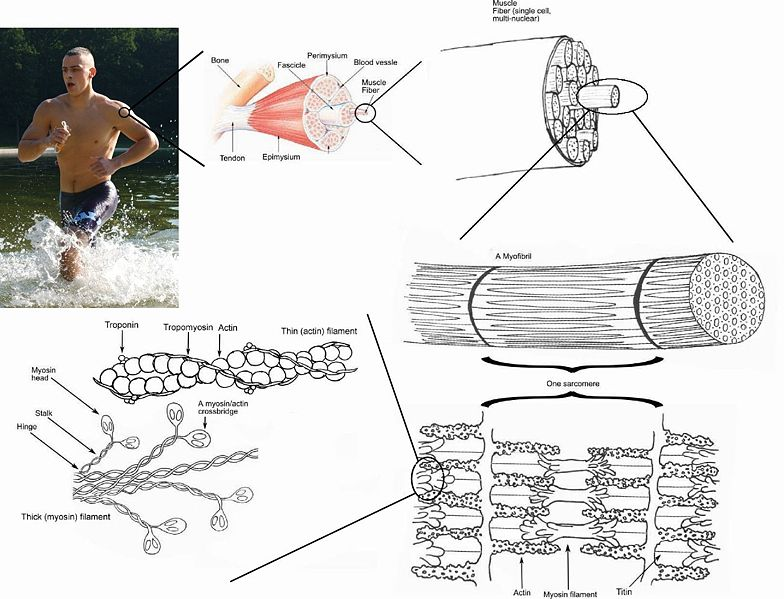Exercise and the muscles
Skeletal muscles are muscles which are under conscious control. Involuntary muscles of the torso are categorised as smooth muscle. Smooth muscle unlike skeletal muscle does not have the ability to contract over long periods of time. Skeletal muscles are made up of slow and fast twitch fibres.
The different fibres are used for different movements, fast movements like sprinting or lifting a heavy weight uses the fast twitch fibre while slow, sustained movements use slow twitch. Within the muscles fibres, mitochondria are structures which produce energy to allow the fibre to contract. Slow twitch fibres have more mitochondria structures than fast twitch. Muscle fibres contain a number of filaments which slide over each creating a contraction or extension.

To enable movement, muscles have origin and insertion points. By looking at these points on a particular muscle you can identify the direction of contraction and its range of movement. This is important when trying to work a particular muscle for fitness, as if you know the best direction of movement to achieve a full contraction and range of movement, you can use that movement within an exercise. Each skeletal muscle of the body has to fulfil different roles depending on the type of movement. The main types of roles a muscle can play are as follows:
- Agonist – Is the prime mover and the muscle which is contracting to perform the movement.
- Antagonist – The opposing muscle of the agonist, which needs to relax and extend to allow movement and the agonist to contract.
- Fixator – Muscle which contracts to prevent any unwanted movement.
- Neutraliser – Muscle or group of muscles which contract to prevent unwanted movement, while permitting the desired action of that muscle
- Synergist - Acts to assist the movement of the agonist.
When the muscle shortens its known as a concentric contraction. An eccentric contraction is the lengthening of a muscle while its under load. When you start exercising the muscles of the body go through some immediate changes, these are; increased demand for oxygen and nutrients, increased nerve stimulation and capillary dilation from increase in blood, rise in temperature, increased pliability and increased fibre recruitment.
Because of the increase in oxygen required the heart speeds up to pump more blood and breathing increases to oxygenate the blood. This is why even if your goal is to improve your muscular strength and endurance, it is just as important to work and improve your heart and lungs. This is why if a smoker tries to lift weights, the muscles will fatigue more quickly because the heart and lungs cannot work effectively.
Over a longer period of time the muscles improve in tone, increase in fibre size, increase resting metabolic rate (see how the body uses energy), increase in the number of mitochondria and capillaries within the muscle.
Commonly a imbalance between postural (tonic) muscles and movement (phasic) muscles occur due to a lack of exercise, stretching resulting in bad posture when sitting and standing. When an imbalance within muscles occur, the body reacts by trying to compensate, but over a period of time this compensation can lead to lower back pain, knee and hips issues. Through correct training and stretching muscular problems are mostly reversible.
Optimal musculoskeletal function requires that adequate range of motion is maintained in joints. A reduction in joint mobility and strength reduces the ability to perform activities within daily living.